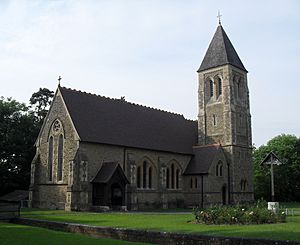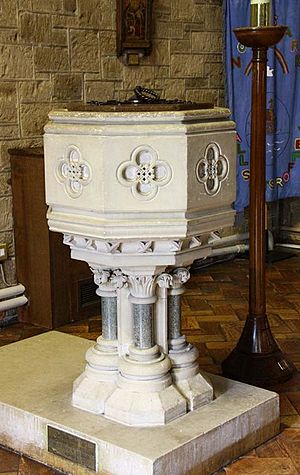All Saints Church, Roffey facts for kids
Quick facts for kids All Saints Church |
|
|---|---|

The church from the southeast
|
|
| 51°04′36″N 0°17′38″W / 51.0767°N 0.2940°W | |
| Location | Crawley Road, Roffey, Horsham, West Sussex RH12 4LX |
| Country | England |
| Denomination | Church of England |
| History | |
| Status | Active |
| Founded | 1856 (in schoolroom); 1878 (present church) |
| Founder(s) | Gertrude Martyn |
| Dedication | All Saints |
| Consecrated | 1878 |
| Architecture | |
| Functional status | Parish church |
| Heritage designation | Grade II |
| Designated | 11 November 2002 |
| Architect(s) | Arthur Blomfield |
| Style | Early English Gothic Revival |
| Completed | 1878 |
| Construction cost | £4,000–£5,000 |
| Specifications | |
| Capacity | 300 |
| Materials | Horsham sandstone; Bath stone |
| Administration | |
| Parish | All Saints Roughey or Roffey |
| Deanery | Horsham |
| Archdeaconry | Horsham |
All Saints Church is a special church in Roffey, a part of Horsham in West Sussex, England. It belongs to the Church of England. This church was built a long time ago, in 1878. Before that, people in Roffey used a schoolroom for church services starting in 1856.
The church was designed by a famous architect named Arthur Blomfield. It was built in a style called Early English Gothic Revival. The money for the church came from a kind widow, Mrs. A. Gertrude Martyn. She wanted to build it to remember her late husband.
All Saints Church is considered very important for its history and design. Because of this, English Heritage has given it a special Grade II listing. This means it's a building that needs to be protected.
Contents
History of All Saints Church
How Roffey Grew
Roffey has been a settlement for a very long time, since the 1500s. It was known for making iron in the past. The area around Roffey was once common land. This means everyone could use it. But in 1812–1813, this land was divided up.
In 1848, Horsham got its first railway line. This helped the area grow a lot. More people moved to Roffey. The main road from Horsham to Crawley also became a turnpike in the 1820s. This made travel easier. Roffey was sometimes called Star Row because of an old inn there.
Building a New Church
Roffey was part of the Horsham church area. But the main church, St Mary's, was quite far away. People started talking about building a church in Roffey around 1840.
In 1856, a school was built on Roffey Street. This building quickly became the first place for church services in the village. It could hold about 90 people. As Roffey grew, people realized they needed a bigger, permanent church.
In 1870, Mrs. A. Gertrude Martyn stepped in. She was a widow from Roffey Lodge. She gave money and land to build a new church. She wanted it to be a memorial to her husband, Cecil Martyn.
Construction and Opening
The famous architect Arthur Blomfield was chosen to design the church. He had designed or fixed many churches in Sussex. Building work started in 1878 and was finished in the same year.
Blomfield used local sandstone for the walls. He also used Bath stone for details. During construction, something unusual happened. A swan flew into the scaffolding around the tower and died. This was seen as a good sign. The Martyn family crest had a swan and a crown on it. The swan's feathers were even used in the altar cloth when the church opened!
The church was finished by November 1, 1878. This day is called All Saints Day. The Bishop of Chichester officially opened and blessed the church. Building the church cost between £4,000 and £5,000.
Life at the Church
Roffey continued to grow after the church was built. The church could hold 300 people. It quickly became very popular. About 125 people usually attended services in its early years.
In 1880, the churchyard was blessed. A J. W. Walker & Sons organ was also put into the church. In 1919, a wooden crucifix was placed in the churchyard. This was Roffey's war memorial. It was damaged in 1971 but was rebuilt and blessed again.
A new house for the vicar was opened in 1967. A church hall had already been built in 1957. For many years, Roman Catholic services were also held at All Saints Church. These services continued until around 2011.
Architecture and Design

All Saints Church is built in the Early English Gothic Revival style. It has a surprisingly large tower. The church is made mostly of Horsham sandstone. Smaller stones are fitted into the walls to make them strong. There is also Bath stone and some brick. The roof is made of tiles, and the tower roof has wooden shingles.
Inside the Church
The church has a main area called the nave. It has an aisle on the north side. There is also a chancel, which is the part of the church where the altar is. The tower, a small room called a vestry, and a porch are all close together.
The inside of the church feels very grand. The roof of the nave is made of timber. It has strong wooden beams that show how carefully Blomfield designed the church's woodwork.
Windows and Details
The main window at the west end has two tall, narrow windows called lancets. Above them is a four-leaf shape called a quatrefoil. Other windows in the nave are also lancets. They are separated by strong supports called buttresses.
The east window in the chancel has three lights. It features beautiful stained glass made in 1878. This glass shows scenes like Christ in Majesty, the Four Gospels, the Apostles, and various saints. Other windows in the church also have stained glass.
Porch and Tower
The porch is made of timber. It has carved decorations. The tower has four parts and a shingled spire. A weather vane sits at the very top. The tower has different kinds of windows, including arched ones and lancets. The top part has arched openings with louvres.
Inside Features
Inside, you'll find many interesting features:
- A stone and marble font for baptisms. It has eight sides.
- A carved stone and timber pulpit where sermons are given.
- Oak choir stalls and Communion rails.
- A wooden confessional.
- The J. W. Walker & Sons organ.
- A stone, wood, and marble reredos behind the altar. It has carvings and mosaic work.
A brass plaque on the north side remembers Cecil Martyn, for whom the church was built.
All Saints Church Today
All Saints Church was officially listed as a Grade II building on November 11, 2002. This means it is a very important building in England. In the Horsham area, there were many listed buildings in 2001, and All Saints is one of them.
The church serves a large area called a parish. This parish covers all of Roffey and nearby areas. It reaches towards the villages of Rusper, Colgate, and Faygate. The official name of the parish is "All Saints Roughey or Roffey." This shows how the area's name used to be spelled differently.
For many years, All Saints Church also held Roman Catholic services. These services were held on Saturday evenings and on special holy days. These services stopped sometime between 2011 and 2013.
See also

